The MTA Needs a Real Capital Plan, Not Unrealistic Promises
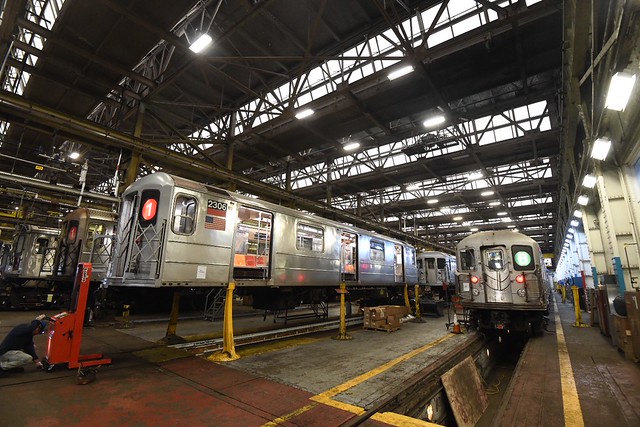
(photo: Don Pollard/Governor's Office)
On Monday, the Metropolitan Transportation Authority (MTA) released an 11-page slideshow “overview” partially summarizing the details of its nearly $55 billion 2020-2024 capital plan. The unveiling seemed like Christmas morning - according to MTA CEO/Chair Pat Foye, the plan will sell itself. Everyone will get the pony that they asked for. NYCT President Andy Byford was “ecstatically happy” and elected officials and advocates were told they’d get their top priorities, ranging from costly expansion projects to new subway and commuter rail cars, buses, signals, and elevators.
Who wouldn’t want a huge infusion of funds into a century old, workworn transit system? We too want to believe! Unfortunately, the numbers just do not add up.
We question both the availability of the funding coming in and the ability of the MTA to spend this massive outlay. Historically, transit advocacy has centered on finding funds, but last year we started looking at actual expenses -- not “commitments” or authorizations to spend, as the MTA does. We found that the real constraint on MTA capital plans has become the ability to spend, not finding funding. (A related problem is keeping costs down so that what can be spent is done so efficiently.)
This plan is really Governor Cuomo’s. He controls the MTA, as described in great detail in our OpenMTA report. There are a few reasons we think his $55 billion “five-year” plan is not tethered to reality. While the Governor’s plan shows that he wants the MTA to spend 70% more on its 2020-2024, the MTA’s capacity to spend that much will not grow nearly as quickly.
In 2018, the MTA spent a record $6.6 billion on capital projects. However, only $4 billion of that was for current projects -- the other $2.6 billion was to complete projects from previous plans.
For about two decades the MTA has gotten further and further behind spending its capital funding. As a result, there is a growing hangover of past-year projects that must be completed every year. We estimate there will be at least $20 billion worth of 2015-2019 projects for the MTA to finish during the 2020-2024 plan.
Let’s assume the MTA can keep capital spending at the record pace of $6.6 billion a year. If it finishes the 2015-2019 plan in five more years, spending an average of $4 billion of the $20 billion per year, it leaves only $2.6 billion a year for 2020-2024 projects. And wait, the MTA still hasn’t finished the 2005-2009 or 2010-2014 plans. Clearly, something is off here.
We believe that projects that will not be built for at least a decade are more aspirational than real. By promising everything to everyone, the Governor is actually making it impossible to know which projects are real and which are not.
Given what was released this week is still technically a draft (and we’ve still only seen an outline, not a full plan) that must be approved by the MTA Board and Capital Program Review Board (CPRB), there is still time for the MTA to release a real implementation plan showing how it intends to finish this new plan along with all its current projects.
How Much Can the MTA Really Spend On a Five-Year Plan During the Plan?
Bluntly, we think it will be difficult for the MTA to spend even half of the $55 billion proposed for the 2020-2024 plan during that five-year period. MTA capital plans often taking more than 10 years to be completed. While this is not a new challenge, a capital program of nearly $55 billion is unprecedented and presents a good opportunity to figure out how to fix this ongoing structural MTA problem.
The MTA’s ability to spend capital dollars during plan years has decreased, not increased. In 2018, the MTA spent $6.6 billion on capital projects, but only $4 billion was for 2015-2019 projects. The MTA’s best-ever year for spending on projects from the current capital plan was in 2009, when it spent nearly $4.5 billion (see chart below).
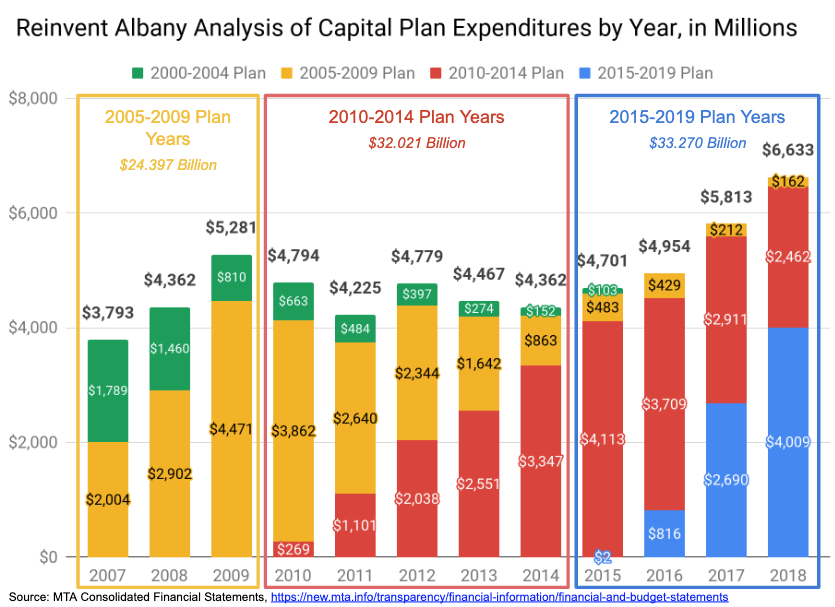
With the 2015-2019 plan’s late start in 2016, there is a lot of work still left to do on that plan. The 2015-2019 plan has $33 billion worth of projects, but the MTA has only received $12 billion in funds as of June 31 of this year, and as of the end of 2018, only $20 billion worth of projects were committed. (A commitment is not the same as actually spending the money, it is the intent to use employees to complete a project or execution of a contract).
Can the MTA effectively manage more than $6.6 billion a year total in capital spending?
Given the MTA’s limited spending capacity, questions about the credibility of delivering a nearly $55 billion capital plan are warranted. With the recently-approved MTA reorganization, consolidating capital construction staff to headquarters will mean that the MTA will have to do even more with even less. Whether centralization will indeed lead to meaningful efficiencies will take time to determine.
Even if we give the MTA the benefit of the doubt and it does as well as it has in the past, getting $4.5 billion out the door every year, it will take 12 years to finish the 2020-2024 plan. This is all while it has a lot more to do on the current, 2015-2019 plan.
Given the limited ability to manage projects, what will the MTA prioritize?
The slideshow proposes what would be the largest investment in signals for MTA New York City Transit ever, at $7.1 billion. This comes with other large investments for elevators and subway cars, all while large expansion projects are continuing, such as East Side Access and LIRR Third Track.
With limited spending and staff capacity, the MTA will have to choose which projects come first and which come last. Janno Lieber, the MTA’s head of capital construction, has said that signals will come in the five-year window, but as of now, the MTA has not released an implementation plan or detailed project list with schedules of when it will commit to projects, as it has shown in prior plans.
Revenue Dependent on New Federal, State and City Fundings
The nearly $55 billion plan outline makes a number of big assumptions about funding that has not yet been secured. New funding is supposed to come from the federal government ($10.7 billion), the state government ($3 billion), and city government ($3 billion), totalling nearly $17 billion. These numbers are not real until the cash actually arrives from all parties involved.
Is it realistic to expect $10 billion in federal aid?
Under a Democratic president, the federal government contributed $7 billion to the last capital plan. This plan assumes even more federal dollars will come in, including a large contribution for Second Avenue Subway Phase 2: $2.9 billion alone. The feds provided $1.3 billion for Phase 1, so this would double that contribution to this project. While the President indicated support for the project via Twitter, a tweet is not a funding commitment of $2.9 billion.
Is it realistic to expect the state to provide $3 billion in direct aid?
While Governor Cuomo has said the state will provide $3 billion to the new plan, this is subject to legislative approval. The proposal of the Mayor’s match of $3 billion is also under review. Meanwhile, the state still owes $7.3 billion to the MTA for the 2015-2019 plan: it had pledged $8.3 billion in 2016 and only $1 billion has come in so far.
State Comptroller Tom DiNapoli, in his recent report on the MTA’s finances, noted that the remaining $7.3 billion will not start to come in until next fiscal year (beginning April 2020). The state also may not provide this as direct aid. It could authorize the MTA to issue its own bonds based on existing or new revenue, meaning that the impact on the MTA and taxpayers is still unknown.
Debt Service and the Operating Budget Crisis
Beyond the MTA’s huge capital needs, it already doesn’t have enough money to pay for the costs of running the system everyday. This is due in large part to debt service payments on previous capital plans. Debt service payments eat up 17% of the MTA’s operating budget now, and the MTA faces even larger out-year deficits.
Even without new borrowing, the MTA forecasts that its debt will increase 31% by 2023 and will cost more than $3.5 billion a year. A hiring freeze and cuts to staff such as subway car cleaners have meant that MTA workforce morale is low, while customers are increasingly unhappy with the quality of service. And “service guideline” cuts are on the horizon for this fall.
Will riders endure even more cuts as a result of this plan?
The operating deficit is already significant, and the MTA’s 2020-2024 capital plan outline assumes the MTA will pay for part of the plan with $10 billion in new debt. How much this debt will increase the MTA’s debt service payments, and therefore its operating deficit has not yet been explained to the public. This information is needed to understand exactly what impact the capital plan will have on the MTA’s ability to actually deliver service for its riders, its primary objective.
Real Transparency is Honesty
Reinvent Albany and our colleagues last week announced the Build Trust campaign, asking the MTA to release an implementation plan to show exactly how it will deliver on its promises, and provided a blueprint for better transparency and cost control. To us, transparency is not merely about putting more data online, but presenting real, honest information to the public.
To comply with state law, the MTA will have to hold a vote on the complete draft capital plan at its September 25 board meeting. As soon as the MTA Board receives the actual capital plan, it is required to be put it online where the public can see it. Yet with less than a week remaining before a Board vote on the $55 billion spending plan, the MTA has not released two important things: (1) the “20 Years Needs Assessment” with a detailed analysis of how much money is needed to repair the system and (2) the full, detailed list of capital projects in the proposed capital plan, with a detailed implementation plan.
When will the MTA release its 20-year needs assessment and federal TAM plan?
In theory, the MTA is supposed to follow a logical process to determine how much it needs to spend restoring the transit system.
First, the MTA is supposed to compile an inventory of its equipment and infrastructure, including the condition of its assets, and then it is supposed to compile its needs assessment of how much it will cost to repair the system so it can provide good service.
The inventory of its equipment is part of a new federal requirement called the Transit Asset Management or “TAM” plan. The needs assessment has taken the form of a 20-year needs assessment, last released in October 2013 for the last plan. Neither of these documents is publicly available for the next plan.
Without a 20-year needs assessment, or the underlying data about its assets, the public cannot know how much the MTA should be spending to replace very old, but crucial, subway and rail components, like decades old mechanical switches, electrical systems, pumps and fans. (See Reinvent Albany’s report on the MTA capital plan process.)
Decisions on capital spending don’t have to be political - they should be based on real data that takes the subjectivity out of the process.
When will the MTA release its full capital plan, with an implementation plan?
The MTA’s 11-page slideshow does not differentiate between “core” repairs versus expansion projects, lumps together costs over multiple plans, omits large capital projects, and provides no implementation schedules. This is troublesome and again raises questions about the MTA’s commitment to public transparency.
Project lists from prior capital plans have tallied more than 60 pages, itemized and coded by type of project. This allows the public to see exactly how the plan breaks out, such as how many fixes to broken equipment there are versus spending that may be more cosmetic, like the last plan’s Enhanced Station Initiative.
Expansion projects are usually expensive, representing an opportunity cost for fixes that don’t involve ribbon cuttings but are crucial like new power stations needed to run additional trains.
These lists have also included project commitment schedules, showing when the MTA intends to commit to projects (again, not spend) during the five-year window. This is the basis for developing a real implementation plan, and should be expanded upon by the MTA as recommended by the Build Trust campaign.
Before the new MTA capital plan is final, the public and stakeholders like the State Legislature -- which should hold hearings this fall before the plan is approved by the CPRB -- need a lot more detail than 11 pages to fully buy in. It is the public’s money after all, and members of the public deserve to be treated like investors who have been given a real, honest plan before staking their own money on the MTA’s future.
***
Rachael Fauss and John Kaehny are, respectively, senior research analyst and executive director of Reinvent Albany. On Twitter @ReinventAlbany.
***
Have an op-ed idea or submission for Gotham Gazette? Email This email address is being protected from spambots. You need JavaScript enabled to view it.
An Unsigned Piece of New York’s Decarceration Puzzle
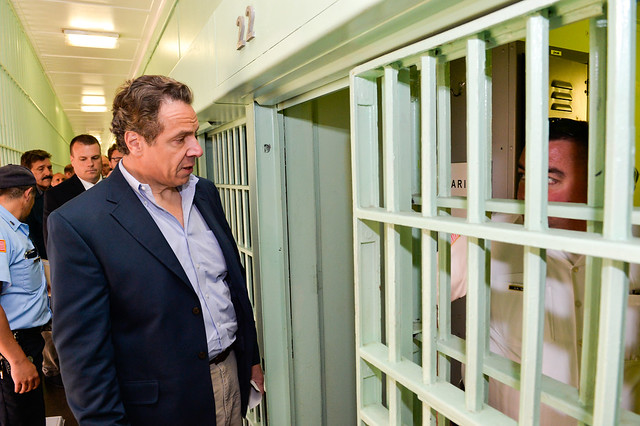
(photo: the governor's office)
Where is Assembly Bill 6980? It updates New York’s Charitable Bail Fund Act to allow approved organizations to bond more people out of jail. The bill passed the Assembly on June 17 and the Senate on June 19, but it hasn’t been sent to Governor Andrew Cuomo, or requested by the governor for his signature, and it’s not clear why.
Bail reform activists finally had their day this year when the New York Legislature passed a comprehensive law that more than overhauled -- it essentially overturned -- the state’s money bail system. It didn’t eliminate the way people pay cash for freedom when they’re legally innocent, but it came close. Of the almost 205,000 criminal cases arraigned in New York City in 2018, only 10 percent of defendants would have needed money for bail if the new law had been in effect.
The new law wasn’t enough for some, though. Carl Heastie, the speaker of the Assembly, admitted that the bail reform law “didn’t go as far as we had liked.”
And that’s exactly why Assembly Bill 6980’s stall-out is both puzzling and problematic. A full and fair reform of the state’s money bail system can’t be realized without it being codified, which members of the Legislature recognized by passing it in June.
Even with the new bail reform law in effect, approximately 20,000 people in New York City alone stand to have their lives uprooted if they’re picked up by police, arrested and subjected to monetary release requirements. Thousands more outside the city face the same risk.
If a judge decides to set a monetary bail amount over $2,000 for a defendant charged with a felony, that person lands in the same situation as before: if he can’t afford to bond out, his freedom will be snatched from him when he’s still presumed innocent and while he can best help his attorneys with a defense. Currently, no bail bond fund can touch him; the law caps the allowable amount at $2,000 and limits assistance to those charged only with misdemeanors.
Assembly Bill 6890 will help fix that. It raises the amount that a charitable bail fund can post to $10,000 and imposes no restrictions on the nature of the charges of the beneficiary of the bail fund, the person who gets bonded out.
Charitable bail funds aren’t new. The first in New York, Bronx Freedom Fund, started in 2008. But it was far from welcomed; a judge sought to shut it down, saying it was illegal. But because it addressed a real need in a state that couldn’t solve the problem of a pretrial detention system that disproportionately pens poor people of color, New York State licensed charitable bail funds in 2012 through the Charitable Bail Fund Act, the law that currently constrains their ability to more fully do what they’re designed to do.
New York City started its own bail fund in 2017 -- the Liberty Fund -- precisely because the city doesn’t control state law, and uprooting the monetized scheme that we call pretrial release wasn’t something the city could accomplish on its own. Charitable bail funds are safety valves when the law doesn’t provide sufficient justice.
It would seem like New York bail funds will have limited utility after the bail reform package goes into effect on January 1, 2020. After all, if money isn’t an issue for 90% of the arrested population, then what can these organizations do?
The short answer is: a lot. In New York City alone, only 43 percent of the almost 5,000 pretrial detainees on April 1, 2019 would have been released under the new legislation. That means that 57% of detainees may remain in custody, even under this revolutionary reform. A study from the Center for Court Innovation found that almost half of all defendants were incapable of paying their bonds immediately after arraignment.
And the likelihood that they will plead guilty, even to crimes they didn’t commit, is about four times higher than if they were kept from confinement while they’re prosecuted. Pretrial release increases the chance that a defendant will be found guilty by about 14.8%. The fact that people enter guilty pleas simply to get out of custody accounts for much of that increase.
While a good number of these people will benefit from and be freed by the new reform law, failing to send this revision of the Charitable Bail Fund Act on to the governor for the final step suggests that lawmakers might have a tad too much confidence in their accomplishments.
Several states have proven that things don’t go exactly as planned when they try to jettison money bail. In California, the bail reform statute never reached fruition even though it was signed by the governor; opposition to SB 10 prevented its implementation.
Even when legislative efforts succeed and laws go into effect, the results can fail. In Illinois, Cook County Chief Judge Timothy C. Evans implemented new rules designed to stop judges from setting unaffordable bond amounts. Initially, it looked like the new rules were working, until judges started setting bonds in untenable numbers to keep people they deemed dangerous incarcerated during the pendency of their cases. The dollar of money baiI set in 30% of cases in Cook County was unaffordable. In Maryland, the system overhaul backfired and ended up causing more people to be remanded to custody than before.
New York legislators had the advantage of knowing about these miscarriages as they drafted their bail reform bill, so they sidestepped many potential pitfalls. They had on their side the fact that New York is the only state to prohibit judges from considering a defendant’s alleged dangerousness in deciding pretrial release conditions. And, luckily, judges in New York City had unofficially decided to lean more towards releasing the people appearing before them prior to the bill’s passage.
But they can’t ignore the opposition to the new bail law that exists and the unfortunate reality that judges will do what they please. If reform does go haywire in New York, poor defendants need a back-up plan. A necessary part of that plan is charitable bail funds being able to fulfill their mission.
The New York Assembly should send 6980 over to Governor Cuomo post-haste.
***
Chandra Bozelko writes The Outlaw column for GateHouse Media and was a 2018 Pretrial Justice Innovator with the Pretrial Justice Institute.
***
Have an op-ed idea or submission for Gotham Gazette? Email This email address is being protected from spambots. You need JavaScript enabled to view it.
Hosting the United Nations Brings Real Value to New Yorkers
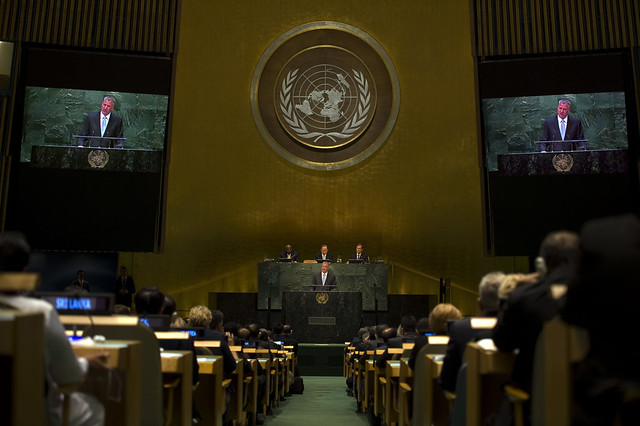
(photo: Rob Bennett/Mayor's Office)
For many New Yorkers, the annual wave of United Nations events, set to start again this week, can be a nightmare: jam-packed subways, bottlenecks on the FDR Drive, and crowded sidewalks that slow our steady gait to a maddening crawl.
What most New Yorkers may not realize, however, is that hosting the UN boosts our economy, draws desirable traffic to local businesses, and elevates city diplomacy on the world stage — and that’s a boon for all of us.
Since 1946, New York City has been the proud, permanent home to the UN and its promise to make the world a better, more peaceful place. We play host to 193 Permanent Missions, over 70 trade missions and 116 consulates – the largest diplomatic community in the world.
With one in three New Yorkers being foreign born and over 200 languages spoken throughout the five boroughs, our city naturally has a special connection to the UN’s member states. Thanks to this enduring bond, New Yorkers actually have a voice on global issues such as human rights, migration, and climate change. We are stalwarts of the UN’s mission to protect and serve a thriving, fair, and just world nation.
The fact is, with record low unemployment, our city has never been more prosperous and the UN community has been part of that success. The UN Headquarters has contributed $3.69 billion to our city’s economy and created thousands of jobs for New Yorkers, according to a 2016 report by the Mayor’s Office of International Affairs and the New York City Economic Development Corporation.
The United Nations is much more than the sum of its economic impact, of course. New York City is living out the mission to achieve the UN’s Sustainable Development Goals (SDGs or Global Goals) by 2030. First launched in 2015, these global targets for fighting poverty, promoting health, and protecting the environment are crucial to all of our futures. The Mayor’s Office for International Affairs has been using the Global Goals framework to showcase our city’s innovations in sustainability with cities and countries around the world.
The global community looks to the U.S. for sound public policy and New York City is leading the way. We’ve learned a lot from other nations as well; innovations in climate, gender equity, and education aren’t limited by borders.
Our children are also benefiting from our international ties. With the support of other city agencies, and in partnership with the United Nations, the Mayor’s Office for International Affairs runs the award-winning Junior Ambassadors program. Over the last four years, thousands of young New Yorkers from across our city have gotten a firsthand look at global politics and learned how they can live out the Global Goals in their own communities.
So congestion and street closures aside, it’s important to stay focused on what truly matters: that when it comes to the local economy and our standing with communities across the globe, the United Nations is good for all of New York City.
***
Penny Abeywardena is New York City Commissioner for International Affairs. On Twitter @PAbeywardena & @GlobalNYC.
***
Have an op-ed idea or submission for Gotham Gazette? Email This email address is being protected from spambots. You need JavaScript enabled to view it.
Community WiFi is Already Here, Now It's Time to Expand It
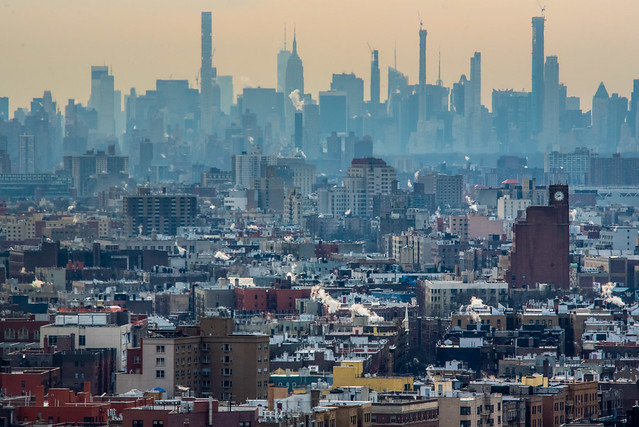
(photo: Michael Appleton/Mayor's Office )
While politicians and industry focus on 5G wireless, the democratization of more common wireless technology has quietly made community-run wifi networks faster, better and cheaper than cable.
Look for wifi anywhere in New York City and you’ll likely find dozens of locked networks, each of which represents (more or less) someone giving a giant consumer internet company like Verizon, Spectrum, or Optimum around a thousand dollars a year. For years, technologists have dreamed of replacing these individual networks with community-run “mesh networks” that would allow people to share fast, secure connections while paying a fraction of the cost of conventional internet service providers.
This dream has, unfortunately, not turned into a reality for the vast majority of New Yorkers, and there are reasons for that.
The cable companies don’t want us to share our online connections because they’d lose a LOT of money -- billions and billions of dollars -- so their consumer internet contracts make sharing illegal. The manufacturers of consumer wifi routers don’t want us to share either, so they don’t make it easy to link routers together in a convenient way for multi-unit wifi sharing. And so, if you think like an internet consumer, efficient wifi sharing just isn’t practical. But if you think like an internet producer, the view begins to change.
Believe it or not, the internet is not a private club that only Optimum, Verizon, and the other consumer internet service providers (ISPs) allow us to access. It’s more like a water system. Consumer ISPs set up plumbing to get wifi (water) from the internet’s “backbone” (think water main) to your house, usually using the same coaxial cable that they laid down to offer cable TV decades ago, and now newer fiber connections.
But others can also build that plumbing.
NYC Mesh is a community-owned and managed internet network committed to creating a more equitable internet by connecting all New Yorkers to high-speed, affordable broadband. To achieve this, NYC Mesh volunteers have collectively built the plumbing needed to take the internet from the “backbone” to the surface, and are now using newly inexpensive wireless radios to move it from rooftop to rooftop, window sill to window sill, to create fast and free community-run wireless networks.
A few years ago NYC Mesh was relatively slow, but thanks to the massive improvements in inexpensive radio technologies, they can now offer speeds comparable to traditional commercial offerings.
So what does that mean? Instead of paying $80/month ($960/year) or more to your cable company, you could connect to NYC Mesh with a $100 radio antenna and get free internet. They request donations of $20/month ($340/year) to keep the shared network running and to help connect the nearly 30% of New Yorkers currently without an internet connection at home. With that donation, subscribers still be saving over $500/year while helping to grow the physical and social infrastructure of a new way to connect online.
There is, of course, a catch -- at least for now. You can only access NYC Mesh if you can point a radio at one of their radios, and their radios currently cover only a small fraction of the city: mostly the east side of lower Manhattan, Chinatown, Williamsburg, Bedford Stuyvesant, Bushwick, Brownsville, Sunset Park, South Slope, Park Slope, Red Hook, Ridewood, and parts of Crown Heights. And even if you live in those neighborhoods, unless you can get a radio on your roof, you might not be able to connect. But the network is constantly growing as new wireless hubs come online every week, so it's likely that it’ll be easy to connect to it in the next few years if you can’t now.
What the network needs most to grow is rooftops where 5-10 foot poles and $240 radios can be placed. If more rooftops were made available, the entire city could be blanketed from the streets to the rooftop in self-organized, self-funded NYC Mesh.
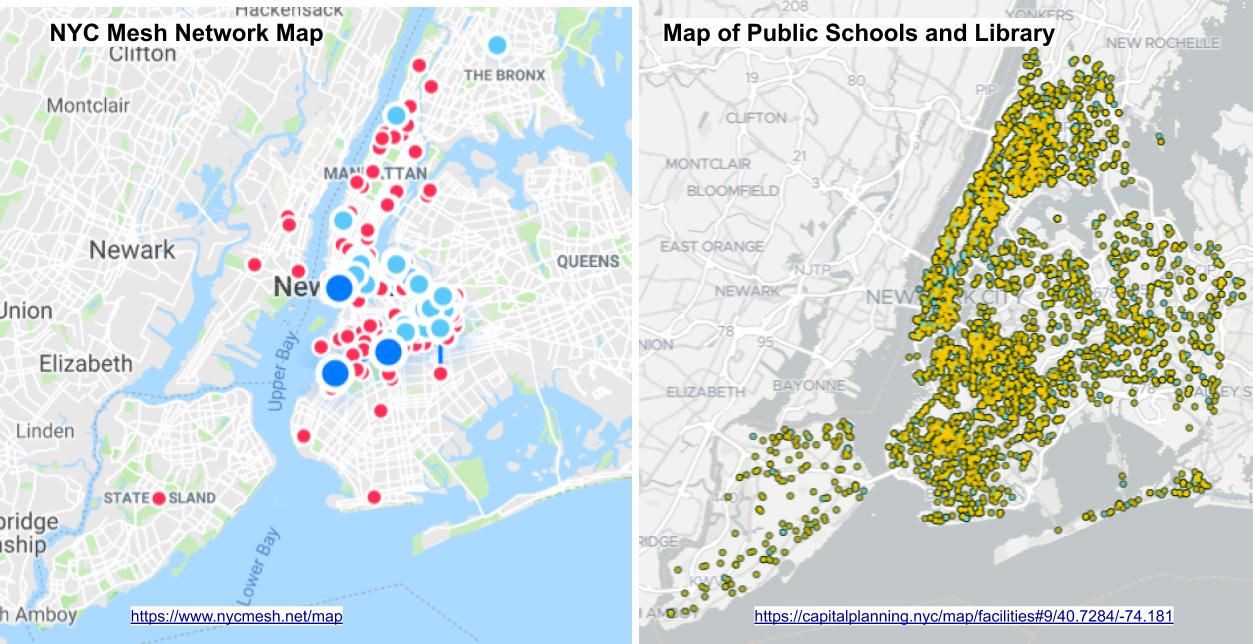
NYC Mesh doesn’t need government money to grow, but it could definitely use government roof tops. New York City’s government has a lot of them. If the city would make rooftop space on its nearly 4,000 public schools and libraries accessible to NYC Mesh, and/or NYCHA would allow rooftop access with agreements to connect residents, then the network could quickly grow citywide.
If New York City had a robust, community-funded, voluntarily-organized network, it would give the city and its residents a significantly stronger negotiating position when dealing with the cable companies, resulting in significant cost savings for everyone.
Grassroots movements like NYC Mesh aren’t waiting for “the city” to act. They’re already working with individual agencies, community organizations, elected officials, and anyone else with an interest in deploying fast and free wifi to where it’s needed most. Manhattan Borough President Gale Brewer, in collaboration with BetaNYC and (my nonprofit) Sarapis, has a demonstration of NYC Mesh technology at her office at the David Dinkins Municipal Building. Her office’s system, which I and other volunteers helped set up, is achieving gigabit speeds and beaming wifi down to City Hall Park and toward City Council and agency staff at 120 Broadway who often complain about their sluggish internet connections.
So, New Yorkers! Consider this your invitation to fast, free wifi. RSVP here.
***
Devin Balkind is a nonprofit executive, civic technologist, and startup advisor running for Public Advocate as the Libertarian Party nominee. On Twitter @DevinBalkind.
***
Have an op-ed idea or submission for Gotham Gazette? Email This email address is being protected from spambots. You need JavaScript enabled to view it.
The Mayor's Missing Pen
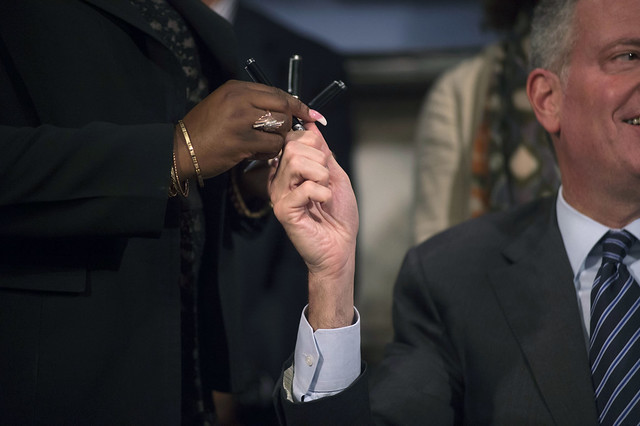
(photo: Ed Reed/Mayor's Office)
Many New Yorkers are expressing frustration at Mayor Bill de Blasio’s lack of attention to his job as he travels around the country campaigning for president. But his laid-back attitude toward the mayoralty manifested itself long before he announced his presidential candidacy.
One particularly illustrative and significant aspect of the job that he has neglected is his role in the legislative process.
First, a quick refresher on how, pursuant to the City Charter, a bill becomes a law in New York City:
-If passed by a majority of the City Council, it is sent to the mayor, who signs the bill into law.
-If the mayor takes no action within 30 days of receipt, the bill automatically becomes law without a mayoral signature (“lapses” into law).
-If during the requisite period the mayor vetoes a bill, the veto can be overridden by a vote of two-thirds of the Council and it then becomes law without further action by the mayor. (City Charter Section 37)
The potential of a mayoral veto, even if it can be overridden, creates a healthy tension that serves as a check on overreach by the Council. By the same token, the potential of a veto override by the Council restrains the mayor from excessive use of the veto pen to block legislation that has widespread support. Thus, the process established in the City Charter creates a checks-and-balances relationship between the executive and legislative branches and requires a level of engagement by both branches in the adoption of new laws.
But in his more than five-and-a-half years as mayor, de Blasio has not vetoed a single bill of the more than 1,000 adopted by the City Council during his time in office. He has not even publicly threatened to veto a bill as an expression of his dissatisfaction with any single one of the barrage of bills that have been introduced (and enacted) during that time.
In contrast, during his three terms in office, Michael Bloomberg vetoed and was overridden on 70 bills out of the total of 987 passed by the Council.
When asked about not vetoing any bills the mayor’s response has been that his team negotiates and helps craft virtually all the adopted bills. There are some high-profile examples, especially related to the NYPD, e.g. the Criminal Justice Reform Act. He would probably also argue that the administration has been able to deter certain legislation, such as the bill to criminalize police chokeholds and the Small Business Jobs Act, though it's not clear if it's the administration or the Council speaker’s office that has been most responsible for sidetracking certain bills. But even in the Bloomberg years, when the mayor and Council speaker were clearly working hand in glove, there were still some vetoes.
Moreover, if de Blasio has played a key role in shaping so much legislation, it is difficult to explain why he has allowed the vast majority of bills passed during his terms to become law without his signature by letting the 30-day time period expire with no action on his part. Wouldn’t he want to associate himself with and take credit for all of the bills he helped shape by signing them into law?
The number of unsigned laws that have lapsed into law has grown from 5 out of 62 adopted in 2014 to a whopping 177 out of 223 passed in 2018.
Of the 156 bills passed by the Council so far in 2019 (as of August 23) the mayor signed only four! By comparison, Bloomberg signed all but 40 of the bills passed during his three terms.
Meanwhile, it is important to ask: haven’t there been cases in which city commissioners hired by the mayor have been opposed to Council bills (whether or not they’ve been allowed to state their dissatisfaction publicly) that they feel are unduly intrusive, costly or burdensome?
For example, surely some of the 845 reports required of city government entities, many through Council legislation, are regarded as inappropriate or unnecessary by agency heads, yet there has been no pushback by the mayor against these requirements when new ones have been added during his tenure.
Not only is this laissez-faire approach bad for morale among agency leaders, but it encourages Council members to introduce legislation on anything and everything because, well, why not? From 2014-2017, during 40 months of legislative session, 1,540 bills were introduced in the City Council; it has taken only 16 months since the 2018 session began to hit the same number of new bills. This volume of legislation is unprecedented.
Is it the case that there is a much more pressing need for City Council legislation now than there has ever been before? Or has the hands-off approach to the legislative process by this mayor led to an aggressive and “anything goes” spirit among Council members?
Let us hope that after the mayor drops out of the presidential race he will give more time and attention to exerting a restraining influence on the proliferation of proposed bills and local laws.
***
Carol Kellermann was president of Citizens Budget Commission from 2008 through 2018.
***
Have an op-ed idea or submission for Gotham Gazette? Email This email address is being protected from spambots. You need JavaScript enabled to view it.
New York Must Pass the 'Rape is Rape' Bill
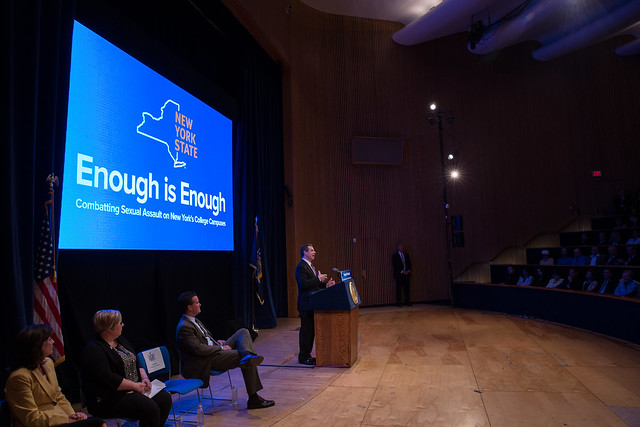
(photo: the governor's office)
At the end of August, NBC New York ran a story about a young woman who was raped after going out to a Manhattan bar. Despite the fact that she came forward, wanting justice to be done, the Manhattan District Attorney refused to prosecute the case.
When a reporter questioned his decision not to pursue charges, DA Cyrus Vance’s staff shared a letter he wrote to Governor Andrew Cuomo insisting that he cannot bring forth rape charges in cases in which victims were voluntarily intoxicated. In other words, if you go out in Manhattan, get drunk, and end up being raped, there is nothing the Manhattan DA can do for you.
It’s a disingenuous claim.
The idea that “prosecutors cannot bring sex crime charges in cases where the victim becomes voluntarily intoxicated and was unable to consent” is simply untrue. We know it’s untrue because the Manhattan DA himself brought charges in a similar case: People v. Johnson.
In that case the Manhattan DA secured a Rape 1 indictment where the victim was voluntarily intoxicated. The Appellate Court ultimately vacated the conviction, but only because DA Vance’s office botched the plea deal.
This is not the first time DA Vance has declined to press charges in a sexual assault investigation, and he’s not the only one with a follow-through problem. Time and time again, law enforcement fails survivors of sexual assault. It’s not a problem unique to DA Vance or New York City but a nationwide “epidemic of disbelief” as Atlantic writer Barbara Bradley Hagerty put it.
Survivors of rape are regularly met with skepticism. Though it’s the police who investigate and DAs who secure convictions, the state Legislature cannot be absolved of responsibility.
Currently, under New York state law, only forced vaginal penetration is considered rape while forced oral and anal contact are labeled criminal sexual acts. Not only is this definition restrictive, it is archaic. There are consequences to this omission: refusing to call rape by its name reduces the perceived severity of the crime.
The Rape is Rape bill (A00794C) would amend the penal code to redefine rape to include forced anal and oral contact, and eliminate the penetration element that is legally necessary to establish that a vaginal rape has occurred.
At first glance, the bill appears an easy sell. Who would disagree that forced anal or oral sex should be considered rape? Equally important is the underlying question. Who would argue that the law shouldn’t recognize that a man has been raped? Well, the District Attorneys Association of the State of New York, for one. The lobbying arm of the state’s DA association has proved a major hindrance to any sort of progressive reform and in 2013, then-DAASNY President Cy Vance wrote to the Assembly opposing the bill on bogus claims that it would reduce penalties for sex crimes.
A similar reluctance to evolve has pervaded the NYPD’s approach. Up until this year, the NYPD was undercounting rape in New York City by as much as 38%, excluding reports of forced oral and anal contact in its official reporting system despite a state mandate to include these crimes in its statistics. Following the Newsy report, we called on the NYPD to immediately bring its system up to federal standards, and the department did.
While the NYPD works to implement a “victim-centered” approach – a result of a scathing city Department of Investigation inquiry that found the Special Victims Division was undertrained and understaffed – the Legislature must do its part and pass the Rape is Rape bill in January, when the next legislative session begins.
And our work does not end there.
We must also elect District Attorneys who will be thoughtful in their prosecutions of sex crimes and take all rape cases seriously, not just the ones they think they can win.
It is especially important that we have DAs who understand that the Penal Code should not only be used to prosecute crimes, but to inform the public of what is acceptable behavior. When we call a rape—whether it is vaginal, oral, or anal—anything but rape, we delegitimize the crime and invalidate the survivor’s experience.
Perhaps the Me Too movement is the cultural awakening this country needs to take sexual violence seriously. That being said, these cultural changes will not happen overnight and in the meantime, we implore the NYPD, New York’s District Attorneys, and the state Legislature to do better.
Everywhere we look our institutions, designated to protect, serve, and deliver justice, are failing survivors. We must take responsibility for these failures and adopt survivor-centered policies while we work to change society.
***
Dan Quart & Aravella Simotas are members of the New York State Assembly representing parts of Manhattan and Queens, respectively. On Twitter @amdanquart & @AravellaSimotas. (Quart is also a candidate for Manhattan District Attorney.)
***
Have an op-ed idea or submission for Gotham Gazette? Email This email address is being protected from spambots. You need JavaScript enabled to view it.
What New York City Must Do to Halt Fear and Misinformation Around ‘Public Charge’
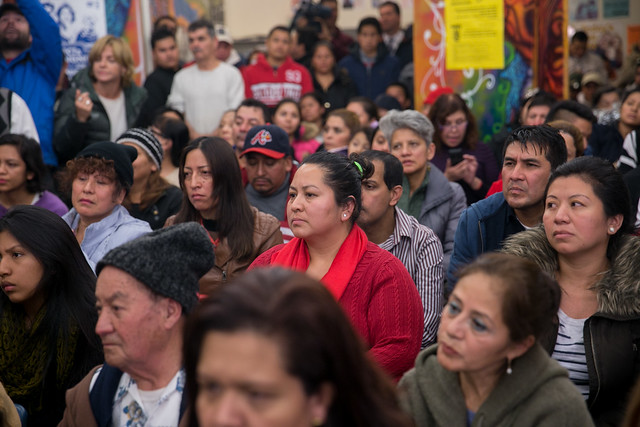
(photo: William Alatriste/City Council)
The Trump administration’s changes to the “public charge” policy are so ambiguous and poorly communicated as to leave little doubt about whether the resulting fear rippling through immigrant communities nationwide was baked into this bigoted scheme.
Here in New York City, we refuse to follow the White House down this dark path. We are the home of Ellis Island, a town built with immigrant hands and made great by the diversity we celebrate. We will fight the imminent public charge policy changes with every tool available and combat the Trump administration’s campaign of fear and misinformation.
This effort must start with our city agencies, which currently do not provide clarity for those new Americans looking for real answers.
New York City’s Department of Education and Human Resources Administration websites detail a multitude of programs and services available for millions of New Yorkers. Ranging from legal aid to emergency food sites, these benefits are lifelines for families in need with nowhere else to turn.
None of these resources, however, inform immigrant families of the federal government’s changes to public charge policy slated to take effect October 15. The policy change will expand the definition of a “public charge” to include immigrants who receive public benefits such as cash assistance, Medicaid, SNAP, and Section 8 vouchers. Those deemed a public charge will be barred from obtaining a Green Card or permanent residence in the United States.
This has grave consequences for hundreds of thousands of immigrant New Yorkers. For some immigrant parents who use public benefits to provide for their U.S.-born children, they may risk losing any chance at citizenship in the future.
The weaponization of our public benefits programs will undoubtedly have a chilling effect on the number of New Yorkers seeking basic necessities such as access to housing, general nutrition and financial security. It will force some to make the unfathomable choice between feeding their children and the dream of becoming an American citizen.
Leaders like New York State Attorney General Tish James and several immigrant-focused social service organizations are already leading the legal fight to block this policy. But more must be done.
It is important to remember this rule change only applies to individuals seeking admission into the United States or applying for adjustment of status. However, the policy’s intentionally misleading language has stoked fear and confusion among a much larger swath of our immigrant population. Some immigrants who may not be affected by the policy change are nevertheless considering disenrolling from these life-sustaining programs out of confusion, fear, or both.
This is where city officials must rise to the occasion, and it is precisely why we have introduced a package of bills in the City Council requiring agencies to create and distribute comprehensive fact sheets and resource materials.
By disseminating information in multiple languages in schools, trusted spaces, and high-traffic government buildings, we can counteract the panic sweeping our city. Our legislation would ensure detailed fact sheets and information on emergency feeding programs are delivered directly to parents, students, and all those who disenroll from Supplemental Nutrition Assistance Program (SNAP) or whose SNAP benefits are set to lapse.
This full-court press will guarantee that nearly every family in New York City would receive this crucial information. These materials will both reassure individuals of their lawful right to public benefits and include information on how to navigate serious issues including how to obtain an attorney and access emergency food.
The danger of this rule change lies not only in its xenophobia, which asserts that America is open only to the wealthy, but also in the uncertainty and fear it strikes in so many of us. It is easy to be scared by the hateful rhetoric that we hear from the president and his acolytes. But if we educate ourselves and each other, we can protect our communities and fight back to ensure our most hardworking, resilient and vibrant communities receive equal treatment.
The blatant attack by the Trump administration on new Americans is in full display across the country as families are separated, detained in horrific conditions, and returned to the perils they fled to seek refuge in the United States. It is up to our local government to provide the necessary resources to all our constituents, regardless of their national origin or economic status. Though the White House may continuously shout at you to go away, this city will honor the lamp that lights the New York Harbor and say to you, welcome home.
***
Carlina Rivera and Francisco Moya respectively represent Manhattan’s District 2 and Queens’ District 21 in the New York City Council. On Twitter @CarlinaRivera & @FranciscoMoyaNY.
***
Have an op-ed idea or submission for Gotham Gazette? Email This email address is being protected from spambots. You need JavaScript enabled to view it.
Congestion Pricing Board Must Be Bus Friendly

Mass transit watchers are eagerly anticipating who will be appointed to the six-person Traffic Mobility Review Board, which was embedded in last April’s state budget deal outlining the framework for instituting a congestion pricing tolling system around Manhattan’s Central Business District (CBD).
All but one member (which is selected by the Mayor) will be appointed by the Triborough Bridge and Tunnel Authority (TBTA). While two appointees will represent Long Island Rail Road and Metro-North interests, we strongly believe one of the other appointees must speak for another critical – yet often maligned – form of public transit: our buses that fuel the region.
While the CBD Tolling Program was born out of a critical need to find a new funding stream for the New York City subways, it is imperative those entities and individuals entrusted with selecting the members of the Traffic Mobility Review Board choose at least one individual who intimately understands the important role buses play in the area’s intricate and complex transportation network.
Beyond the city’s impressive public bus fleet, there is a much larger contingent of commuter, tour, charter, and sightseeing bus companies providing interstate travel from throughout the United States right down to local New York City streets, serving millions of daily commuters, seniors, students and visitors. These private providers of mass transit are a critical piece of the traffic mobility puzzle; delivering a safe, viable transportation solution; and constantly feeding a major economic engine that drives commerce throughout all five boroughs and throughout the New York metropolitan region and beyond.
One bus does the job of as many as 55 single-occupancy cars bringing commuters to work, students to school, shoppers to small businesses, and visitors to vibrant and thriving destinations across New York City seven days a week, 365 days a year. Buses bring one thing Amazon cannot ship in a box – the quick and immediate infusion of capital into the local New York City economy.
On behalf of our diverse group of private operators both large and small, we share the same objectives of reducing congestion and greenhouse gas emissions, while encouraging residents and visitors to consider mass transit. Our subways and rails cannot accomplish this alone.
Congestion funding should also be considered for the expansion of dedicated bus lanes and parking infrastructure, which will ensure improved safety and mobility. From filling the voids left by mass transit deserts scattered throughout the region to counterbalancing the ill effects caused by the proliferation of for-hire vehicles and e-commerce deliveries clogging streets, private buses deserve to be recognized by placing a member of the bus community on the Traffic Mobility Review Board. After all, private and public buses were part of the solution when London implemented congestion pricing, and they are a key part of the solution in New York now.
From pricing to technology and possible exemptions, the decisions that lie ahead for the Board will have a long, lasting impact on the New York City landscape – if not the entire tri-state region. BUS4NYC members are working every day for all New Yorkers who ride the bus and many others impacted. So, too, should this new board.
***
Glenn Every is president of BUS4NYC, a New York City-based advocacy group comprised of private bus company operators, related businesses and associations promoting the industry as a viable transportation solution and local economic driver. On Twitter @BUS4NYC.
***
Have an op-ed idea or submission for Gotham Gazette? Email This email address is being protected from spambots. You need JavaScript enabled to view it.
As We Fight for Further Decarceration and More Community Investment, the Plan to Close Rikers Must Move Ahead
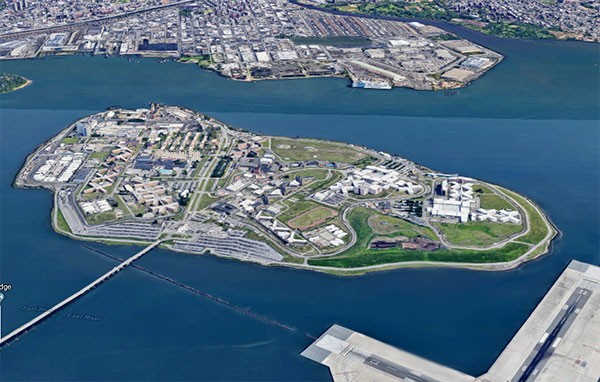
(photo: imagery ©2019 Bluesky, Maxar Technologies, Sanborn, USDA Farm Service Agency, Map data ©2019 via Google Maps fair use policy)
As an organizer directly impacted by incarceration, I often ask fellow New Yorkers that have been previously incarcerated to imagine what it would feel and look like for our communities to have the resources we need to remain in our neighborhoods and thrive.
Our work will solidify New York City as the most decarcerated big city in the U.S. We have done the difficult work of significantly decarcerating New York City and State, forcing the city to shrink the jails system from 12 citywide to four borough-based facilities with improved conditions. Based on pretrial reforms we achieved at the state level, the city has also planned to reduce jail capacity from approximately 15,000 to 4,600 people — officials are estimating the city’s jail population can soon reach 4,000 and we are pushing to reduce that to less than 3,000 in the coming years.
The mayor has answered our demands with his proposed jails plan, which should be passed by the City Council, while improving the plan by supporting our push for further decarceration, a faster route to decarceration, facilities that respect people’s dignity and provide the resources and services every person deserves, and an end to the Department of Correction’s reign of terror.
While this work to decarcerate and to shrink and humanize the system is vital, we also demand that the mayor and the City Council provide the resources that enable us to build communities that flourish.
More than three years ago, I joined other leaders — who had directly experienced Rikers — on a mission to close Rikers and build communities, with the end goal being vibrant resourced neighborhoods and complete transformation of justice in our city. We drew inspiration from the plans for healthy communities laid out by the Black Panthers and Young Lords.
Drawing on a series of community forums (#buildCOMMUNITIES) held last year, we have worked with over 60 partners and advisors from more than 30 partner organizations and groups, along with more than 200 people representing families and communities impacted by incarceration in New York City to put together demands tied to our vision of shifting funds from law enforcement to community resources, providing a roadmap for New York City to make a bold shift from the status quo to a city that lives the values of equity and racial justice.
I was incarcerated for a total of seven years and was 16 years old the first time I was on Rikers Island. One of the things I learned about Rikers is it prepares you to go in, but not to get out. When I came home at the end of 2008, I felt less than human, which is actually the point of Rikers Island — to dehumanize. I didn’t know how to return back to the world, so I just kept doing the things that landed me on Rikers. I was incarcerated again at 19 years old.
I’ve been home for good since 2014 and I have dedicated myself to ensuring young people have more resources and possibilities than I once did; that means closing Rikers, shrinking the jail system, and building and investing in communities where no one should worry about coming into contact with the justice system.
Last week, I visited #CLOSErikers campaign member Sugah Tavarez at the Frederick Douglass Houses in Harlem — the neighborhood where she and her family have lived for many years. Despite the lack of wealth, there is something that the people at Douglass Houses have always had: their love for their community and for justice.
On the day I visited Sugah, she was planning to fight to preserve a community garden so that her neighbors can grow and have access to affordable fruits and vegetables. Community gardens are important in connecting people across generations and providing space for neighborhoods to grow stronger.
Sugah brings people together not just around wellness, but to learn their rights in an overpoliced and gentrified community where black and brown people are determined to stay and thrive. In communities that have always borne the brunt of the system of oppression, we see so much of what we don't want — jails, trauma, poverty, racist policing. Despite that, we've been able to build a vision for what we do want.
We are New Yorkers and we are fighting for the only home we know. Our communities are gentrified by people from all over the country, we invite newcomers to follow the lead of directly impacted people and support our vision for reinvestment.
We are fully committed to ending systemic racism and New York City's reliance on criminalizing people for issues that have solutions in public health, education, environmental, and economic justice. As we dismantle the injustices that harm us, we are building power and visibility of our collective humanity and our demands, as impacted people, who have agency to build communities based on our needs and healing.
There can be no more delays. Closure has been delayed in the past, leaving people to continue to suffer and die at Rikers. The City Council must move forward with the current plan along with the important conditions we have laid out. Our communities cannot wait.
****
Vidal Guzman is an organizer at JustLeadershipUSA. He was incarcerated on Rikers and has been a leader on the #CLOSErikers campaign since 2016; he is from Harlem and a leading architect of the #buildCOMMUNITIES platform. On Twitter @iamvidalguzman.
***
Have an op-ed idea or submission for Gotham Gazette? Email This email address is being protected from spambots. You need JavaScript enabled to view it.
Why It’s Time to Re-think Bloomberg Era Gifted & Talented Programming in New York City

(photo: Rob Bennett/Mayoral Photography Office)
Last week, Mayor Bill de Blasio’s School Diversity Advisory Group (SDAG), on which we served, released its second report calling for all students to have access to enrichment opportunities as a forward-looking replacement for the city’s antiquated system of “gifted and talented” education programs. This provoked a significant volume of responses from a variety of stakeholders who have come to see G&T programs as legitimate and needed. But it is essential that anyone considering what the SDAG is recommending have the full picture -- of both the group’s recommendations and the research they are based upon -- before judging the conclusion.
As SDAG and other critics have noted, the separate and unequal G&T programs are problematic on several levels, in large part because most of them admit students based on an arbitrary cut-off score on one standardized test. In addition, they are disproportionately located in affluent areas of the city and relatedly, serve a disproportionate number of white and Asian students.
This racially and ethnically segregated G&T system reflects the biases that work against the broader understandings of intelligence, ability, and giftedness that sustain our culturally diverse city and our creative and entrepreneurial economy. Research on child development, learning, and culture tell us this is the wrong way to organize schools and label children.
As members of SDAG, New York City public school parents, a researcher (Amy), and a Community Education Council President for District 16 (NeQuan), we argue that New York should lead the national movement to shun so-called gifted education programs in favor of universal enrichment programs that allow all our children to reach their highest potential.
It is important to note that SDAG’s recommendation is holistic -- not simply to throw away G&T and leave everything else as-is -- and grounded in a vast body of evidence about the appropriate uses of standardized tests and programs that separate those labeled “gifted” based on test scores alone.
For instance, the American Educational Research Association, the American Psychological Association, and the National Council on Measurement in Education released a joint statement on the uses of standardized testing in education, proclaiming that, “Decisions that affect individual students' life chances or educational opportunities should not be made on the basis of test scores alone.”
This joint statement issued by three of the most prominent research associations in the field of education sums up the research evidence on standardized tests and their appropriate uses. It echoes the frustration of millions of parents in New York City and elsewhere who know that their children’s intelligence and ability, their gifts and their promises, cannot be measured by one test taken at the age of four.
The inaccuracy of one standardized test to measure individual “giftedness“ is reflected in the stark racial disparities in enrollment in New York City’s G&T programs, which are less than 25 percent black and Latinx in a school system that is 75 percent black and Latinx. These demographics are testimony to not only the racial disparities in income, parental education levels, and access to educational resources. They also reflect the cultural biases inherent in standardized tests that only accept one right answer to questions that could be open to different interpretations when examined through different cultural lenses.
We know, for instance, that the research on how people learn concludes that intelligence is shaped by culture and experience, and that the best test-takers have had life experiences most culturally aligned with the test-makers. A cultural lens through which tests are written and perceived suggests that rather than measure a pure or objective form of “intelligence,” they measure a culturally-shaped understanding of who has knowledge that is aligned with those who wrote the exams.
A 2018 report by the National Academies of Science, Engineering and Medicine concluded that the cultural contexts in which students grow up affect their ability to answer test questions. When these tests have dire consequences for students’ access to educational programs, they can also have a deep and negative psychological impact on students’ sense of themselves.
Even researchers and educators who once advocated for separate G&T programs for those students with good test scores have changed their minds, calling on more parents to “rethink” gifted education and consider whether these narrowly defined programs even make sense. In research that The Public Good Project has conducted in New York City on racially diverse schools, we have studied schools that have eliminated their G&T programs, and they are thrilled.
As one teacher noted, echoing all of her colleagues: since the school eliminated the G&T program, there is much more diversity at the classroom level and the parents who choose the school now really value that diversity over a label. She said that when the school had the G&T program, the students were more segregated and isolated. Now, she said, “I have a few students who I think would probably test into talented and gifted but their families don’t even bother, and I think it’s because they know that’s it’s great instruction and it’s a nurturing environment…and it’s a truly diverse school and I know that’s rare in the city.”
But why is it so rare in a city like New York, when these research findings are but one reason why a growing number of educators and parents are rejecting the “gifted” labels for programs and students? Through experiences as parents in New York City public schools we know that G&T programs within a racially and ethnically diverse district like District 3 in Manhattan lead to unacceptable levels of racial and ethnic segregation between and within schools. They also lead to skewed understandings of which schools are “good” even when schools that enroll students with lower test scores have stronger curricula and better teachers.
In the predominantly black and Latinx District 16 in Brooklyn, parents fought to bring G&T programs into their schools. Nevertheless, when a new program was added, it was underfunded and low quality in part because the teachers were not well prepared. Thus, the addition of this G&T program led to more divisiveness within the district as only a small number of students gained the “gifted and talented” label.
This divisiveness occurred even when the program used broader criteria and admitted students for third grade instead of kindergarten, making it less problematic than the majority of G&T programs in the city. While the D16 parents thought they were achieving more equity by gaining a G&T program, they soon realized that adding G&T created a bigger set of equity issues, making many of the district’s constituents eager to pilot the new, SDAG-recommended Enrichment for All program.
For the sake of our children, our city and our racially and culturally diverse nation, we hope that District 16 can provide the model we need for an enrichment program that will lead the way to a more humane system that identifies the multiple gifts and talents of 1.1 million students. It’s time to let go of our 20th century model of educating a small number of students with poorly-defined academic "gifts" and adopt a 21st century model of appreciating the many different gifts within students and the family and community cultures that foster them.
***
Amy Stuart Wells is a Professor of Sociology and Education and the Director of Reimagining Education at Teachers College, Columbia University. NeQuan C. McLean is the President of the District 16 Community Education Council in Brooklyn. They are both members of the Mayor’s School Diversity Advisory Group.
***
Have an op-ed idea or submission for Gotham Gazette? Email This email address is being protected from spambots. You need JavaScript enabled to view it.
Closing Rikers: We Must Do Better Than The Current Plan
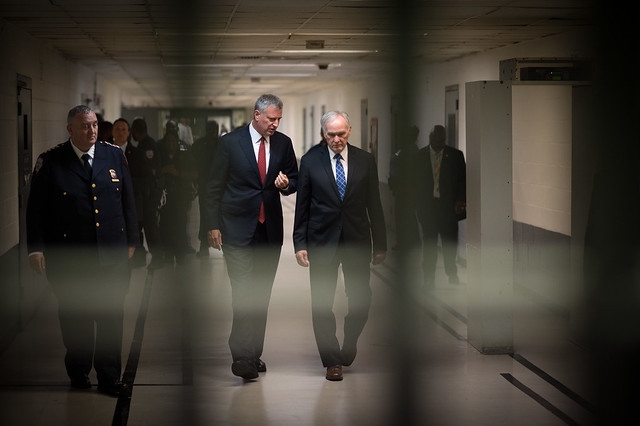
(photo: Michael Appleton/Mayoral Photography Office)
Not long ago, closing the Rikers Island jails was a radical idea. Today, however, less than four years after we launched the #CLOSErikers campaign, New Yorkers have reached political and popular consensus that closing the jail complex is morally imperative. Yet, they are increasingly opposed to Mayor Bill de Blasio’s visionless approach to executing this important mission. Today I write to join that opposition.
The purpose of the #CLOSErikers campaign was not only to shut down a horrific penal colony, but also to decarcerate New York City and spur investment in communities most harmed by mass incarceration. Our principal target was Bill de Blasio, who as mayor oversees the city jails and is empowered to close them.
From the beginning of 2016, we pursued the mayor across the city, in the streets, and at City Hall, in the press and through social media, at his fundraisers and even at his gym. Closing Rikers became a rallying cry for progressives, and then a mainstream political position.
In April 2017, Mayor de Blasio reluctantly announced that Rikers would close. We celebrated that moment as a major step forward, but not as a win, given the scant details in the mayor’s plan. Though I am no longer with the campaign, I have watched for the past two years to see if the mayor’s plan could be improved to match the values of today’s criminal justice reform movement. Despite fierce pushing by advocates, as of Tuesday's City Planning Commission vote, this administration does not have the right plan to close Rikers.
First, the mayor’s plan projects the need for too many jail beds.
The historic and comprehensive pretrial justice legislation that advocates got passed in Albany six months ago, and that takes effect in January, may halve the number of New Yorkers in jail.
Second, the mayor’s plan doesn’t significantly change the culture of Rikers -- retaining the use of solitary confinement, and not holding the Department of Correction accountable for continued violence at jails across the city.
Third, the mayor is simply not engaged. It’s easy to mock Mayor de Blasio for his lonely trips through Iowa and New Hampshire, but it has now been months since the mayor addressed criminal justice reform, and he has apparently neglected to even assign a deputy mayor to the mammoth project of closing Rikers.
There was a time when Mayor de Blasio’s borough-based plan, for all its flaws, seemed like the best and only chance at closing Rikers. But the politics of Rikers and the politics of New York have changed. Every known 2021 mayoral candidate is for closing the Rikers jails. With a stable Democratic State Senate, we can keep improving the broken laws that led to our current system. And across the city, voters are demanding reform from their district attorneys. As circumstances shift, our policy on what is best for New Yorkers must evolve.
As a city, we can settle for Mayor de Blasio’s eight-year, $10 billion plan, or we can push him to generate a better plan that invests billions into helping communities directly, doesn’t have towering jails, and reforms the Department of Correction. It’s not too late, we still have a choice.
Here’s a different path forward, some of which can be demanded by the City Council through the land use review process (ULURP) that is only part-way through and now in the Council’s court:
First, dramatically reduce the number of projected jail beds, including exploring options that would require no new jails to be built and improve conditions at existing non-Rikers facilities.
Second, make a serious financial investment in community-based mental health centers where people can get treatment outside the jail setting, and allocate more funding to transitional housing.
Third, divert people otherwise sentenced to misdemeanor jail terms to programs that can help them get their lives on track.
Fourth, properly implement bail, discovery, and speedy trial reform in 2020, which will dramatically lower the number of New Yorkers in our jails.
Fifth, pass parole reform next legislative session in Albany, which will dramatically reduce the number of New Yorkers in city jails for technical parole violations.
Sixth, work with community groups to expand restorative justice models that empower survivors and hold defendants accountable without using incarceration.
Seventh, demand that our elected district attorneys treat jail as a last resort.
These solutions will be better for our community and improve public safety in the long run, without building huge new jails.
Finally, I commend the Herculean work of advocates, directly impacted people, City Council members, and even certain de Blasio administration members for working to close Rikers, including those who have sought to improve the borough-based jails plan. We are in this together as a city.
We only get one chance to close the Rikers Island jails, and we can do better. Mayor de Blasio and the City Council should act boldly to reimagine criminal justice in New York City.
***
Janos Marton is campaign manager for the ACLU Smart Justice Campaign and a 2021 candidate for Manhattan District Attorney. He managed the #CLOSErikers campaign 2016-2017. On Twitter @janosmarton.
***
Have an op-ed idea or submission for Gotham Gazette? Email This email address is being protected from spambots. You need JavaScript enabled to view it.